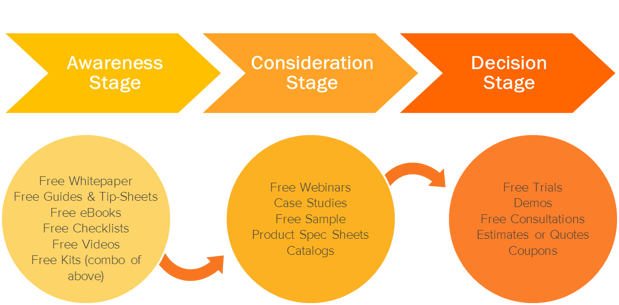
If you’re generating an increasing number of leads for your company, that’s great - but only if those leads are relevant and high-quality. Have you considered how much of the sales team’s time is being spent on leads that you deliver but never turn into customers?
As a marketer, it’s your duty to bring in the leads that will create business for your company and keep it alive. You’re busy doing a million things toward this goal—wouldn’t it be great if your efforts were rewarded with more qualified leads that actually turned into profit?
Here are nine tips that will help you increase qualified B2B leads that are more likely to turn into real business.
1. Align your sales and marketing teams and goals

Some marketers consider their sales team their #1 customer. If the sales team isn’t happy, the marketing team isn’t doing a good job.
Like it or not, your function in your company goes hand-in-hand with that of the sales team. Because the job you start, they need to finish.
If you want to provide sales with more qualified leads, you need to work with sales.
First, the communication lines between marketing and sales need to be open and active. You should constantly discuss what works and what doesn’t, and collaborate to design strategies and processes that are mutually beneficial.
Second, marketing and sales must work together to define what an ideal, high-quality lead looks like. Only with a clear understanding of what sales considers to be an ideal lead will you be able to deliver, because you’ll know exactly what kind of prospects to be targeting and also how to score the leads you generate.
Third, your buyer personas need to be aligned. This might sound like a no-brainer, but in some companies the buyer profiles marketing uses to guide their campaigns are different than the buyer profiles the sales team has constructed.
At the end of the day, it’s the sales team that knows best what your most common type of customer is, what types of customers are likely to create repeat business, and what challenges your buyers are facing. This is why it’s imperative that marketing and sales work together to create buyer personas. It’ll go a long way toward ensuring that your marketing activities generate the qualified B2B leads that sales wants (and your company needs).
2. Make a lead grading system

Lead grading, or lead scoring, is one of the most basic techniques that help marketers understand which leads are ready for engagement by sales. You should only forward your sales team the leads that are most sales-ready – not every lead that comes through your virtual door.
Together with your sales team, create a lead grading methodology by which you rank your leads. You could choose to work with a points system that will assign leads a ranking like A, B, C, etc. Or you could classify your leads by how “hot,” “warm,” or “cold” they are. With the proper grading, you’ll know which leads sales should be spending their time on.
A lead grading system will also help you generate the most qualified leads from your various marketing campaigns. Let’s say, for example, that you’re going to be running a free webinar about one of the products your company offers. Your lower-grade leads might not be using that type of product, so the grading system will help you decide not to target them with the webinar campaign. You can use your lead grading system to ensure that your campaigns are only targeting the right prospects, thus generating more qualified B2B leads for your sales team to spend their time on.
3. Implement account-based marketing

Account-based marketing, or ABM, is a great way to ensure that you’re delivering qualified leads that your sales team has a good chance of closing. Also known as “key account marketing”, ABM is a strategic marketing method in which a company engages and communicates with prospects in a personalized, tailored way - as if they were individual markets.
How does ABM help you generate high-quality B2B leads? Well, the core of account-based marketing is that you create a list of companies that you want to target (as opposed to general buyer personas), and you create a content strategy designed specifically for them and the various decision makers of each one. That way, any engagement you get in return is guaranteed to be from qualified leads.
The first thing you need to do to get started with account-based marketing is sit with your sales team to create a target account list. How detailed you’ll go in defining your targets is up to you; the more specific you get, the smaller your list will be—but the leads you’ll get in return for your efforts will be very sales-ready. Questions to consider when defining your target accounts include:
- Which types of companies are my ideal customers and what are their industries?
- How many employees do these companies have?
- What is their annual revenue?
- Where are they located in the world?
4. Integrate your online and offline marketing activities

As a seasoned marketer, you know that hanging out where your customers are is an important part of your job. That’s why you attend tradeshows and conferences, and other special events that get you face-to-face with your prospects.
While at these events, make sure you’re integrating your online marketing activities with these in-person encounters. One of the easiest ways to do this is by asking for an email address so you can send the prospect some interesting articles or premium content, like a free ebook or webinar recording, for example. You could also run an online campaign valid only for those potential leads who will be at the event.
While the people you speak with won’t always be ready to become a customer on the spot, engaging with them online after you’ve met in person can be a great way to nurture a lead that will eventually become sales-ready.
5. Create a marketing-sales feedback loop

You need to remember that the work you’re doing is part of a cycle that continuously goes back and forth between you and the sales team.
After you send a lead to the sales team, you need to find out what happened next.
Especially in the game of B2B lead generation, where sales cycles tend to be lengthy and somewhat complicated, the sales and marketing teams need to be in constant communication about what’s going on with the leads that the sales team is working on.
Don’t wait until a sale is complete to have this conversation. By regularly speaking with the sales representatives about what’s happening with the leads you’ve delivered to them, you can garner the information needed in order to better manage the lead generation campaigns you’re currently working on.
Ideally, you should sit with your sales team weekly for an update about their progress and implement their feedback to intelligently improve your marketing efforts.
6. Commit To Lead Nurturing

Get this: Forrester Research found that companies that took lead nurturing seriously generated 50% more sales-ready leads at a 33% lower cost per lead than other companies!
When you nurture your leads, you’re increasing your chances of earning their business - when they’re ready. Sure, some leads will be ready to buy when they reach you. But most won’t, and lead nurturing is what will allow you to maintain a relationship with them that will eventually turn into a sale. Don’t miss the opportunity to create a qualified lead out of people who reach your site with the sole intention of researching. Grab them, nurture them with useful, valuable content, and watch how they turn into qualified leads and then customers.
Read our earlier blog post for more information about lead nurturing and how to implement an effective strategy.
7. Make data-driven decisions to improve productivity

There’s a lot you can learn from all the data your company has on past customers and sales cycles. If you’re really committed to doing everything you can in order to generate more qualified B2B leads, you should make use of this data to base your current strategies and processes on.
For example, you can use historical data to help you define your lead grading system. Based on your company’s past experience with leads who turned into customers and those who didn’t, you can discover trends regarding what behaviors were common among both types of leads. Then, you can use this knowledge to grade current leads.
By analyzing the data you have available to you, you can garner real insights regarding the indications that a lead will or will not convert. Not only will this knowledge help you be more efficient, you can even use it when you’re working with your sales team on creating buyer personas.
8. Understand and improve your customer journey
 Source: HubSpot
Source: HubSpot
The customer journey relates to the various ways you engage with a lead from their first interaction with your company through to when they become a paying customer.
But what if you looked at the customer journey as a way to help speed up the process for the sales team?
From this point of view, you’re not only considering whether the content you’re delivering to your prospects is appropriate at every stage, from Awareness to Decision. But you’re also considering what your prospects’ behaviors are telling you about your marketing materials and website, and you can make any necessary changes according to those insights.
For example, if you’re seeing that prospects are regularly dropping out at a particular stage of the buyer’s journey, you can examine that stage to see whether there’s something missing in the information you’re providing. Likewise, if leads you’re generating from a particular content item aren’t converting, perhaps you need to obtain more qualifying information from them in the download form so you can better grade and nurture them.
By being mindful of the customer journey and constantly making improvements to it, you’re helping generate more qualified B2B leads that your sales team will have an easier time closing.
9. Test, Analyze, Optimize, Repeat

With everything being digital these days, it’s never been easier to test, track and analyze your efforts.
Testing your strategies can give you real benefits in terms of generating qualified B2B leads. With every marketing campaign you run, there are always a variety of aspects you can test.
- What time of day are you sending your emails?
- On what day of the week are you posting on your blog?
- What kind of social media posts gets the most clicks?
- What types of information—for example, price or value—are your prospects responding to more?
The work of testing doesn’t end with optimizing your strategies, but rather by examining what approaches generated the most sales. Keep in mind that the work of testing, analyzing and optimizing will never disappear. Technologies change. People’s preferences shift over time. If you want to keep generating the most qualified B2B leads, you’ll need to continuously examine what you’re doing and improve upon it based on the response you’re getting.
Are you ready to start increasing the number of qualified B2B leads you bring to your business? Download our free ebook “The 30 Greatest Lead Generation Tips, Tricks & Ideas”, today, for suggestions on how to do it right.





